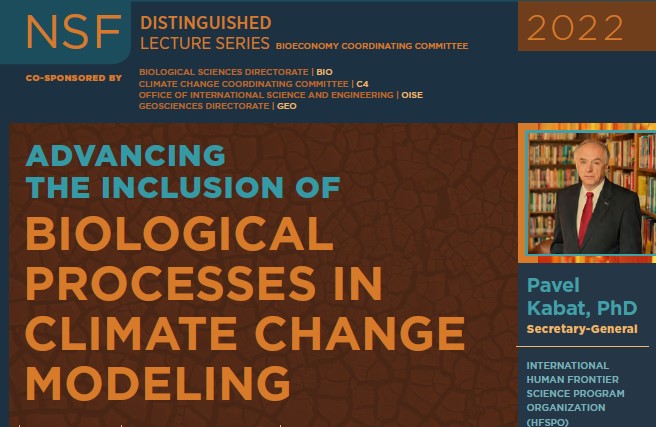HFSPO Secretary-General Pavel Kabat has been invited to participate in the NSF Distinguished Lecture Series organized by the Bioeconomy Coordinating Committee of the National Science Foundation (NSF). Dr. Kabat’s lecture on “Advancing the inclusion of biological processes in climate change modeling” will take place online from 9:30 – 10:30 am (ET) on the 28th April.
You can view the lecture on 28th April here.

Abstract by Pavel Kabat
Vladimir Ivanovich Vernadsky, a Russian, Ukrainian and Soviet mineralogist and geochemist, the founder of the Ukrainian Academy of Sciences, and an important pioneer in the scientific bases for the environmental sciences, hypothesizes, in his 1926 book “Biosphere”, that life is the geological force that shapes the earth. He was one of the first scientists to recognize that the oxygen, nitrogen and carbon dioxide in the Earth's atmosphere result from biological processes, and already in the 1920s he argued that living organisms could (re)shape the planet in the same manner as any geological or physical force.
Yet, it has taken a long time to recognize the fundamental role of the terrestrial and marine biosphere in understanding and modelling the Earth’s climate system. Just 30 years ago, most (physical) climatologists were still convinced that we only need to understand atmospheric and ocean dynamics, and how these interact and are coupled, to be able to model global climate and its changes due to anthropogenic forcing. The Earth land-surface played a marginal, and heavily oversimplified, “inert” role. When the first global dynamic vegetation models (DGVMs) were developed and combined with climate models back in the nineties, a whole array of fundamental problems surfaced, most of which were very persistent and extended into the current generation of Earth system and climate models. These include – by way of example – questions of biological controls of plant water and nutrient uptake, atmospheric carbon dioxide uptake, photosynthetic assimilation and growth, emissions of biogenic aerosols and interaction with cloud formation processes, the autonomous adaptive behavior of living systems, and scaling methodologies from a basic process at the molecular level to regional and global levels. Most of these processes are still over-simplified and over-parameterized even in the current generation of our models, and lead to major and persistent uncertainties, which in turn are often again addressed by numerical /computing and statistical (ensembles) methods and tools, rather than by calling on increased understanding of underlying fundamental (biological) processes.
One of the reasons behind this clearly unsatisfactory situation is a lack of systemic collaboration between fundamental biology science communities and the earth system/climate research and modelling community. In my lecture, I will discuss specific examples of how beneficial such a collaboration could be, not only for basic understanding of the climate system, but also in researching ways to mitigate and adapt to climate change; and will be advocating for breaking further the academic, disciplinary, institutional and funding silos as an urgent step in addressing these key 21st century challenges.


































